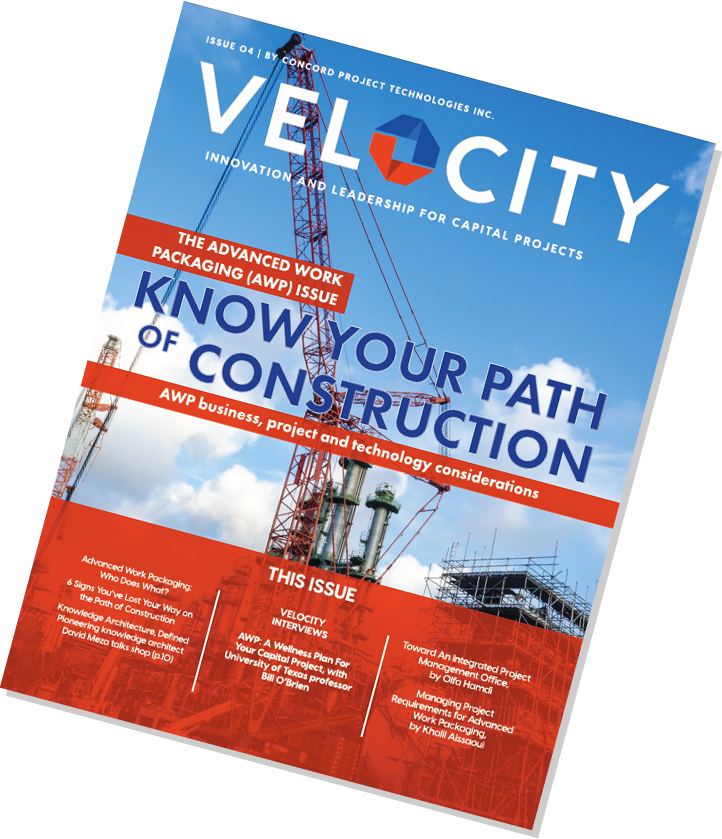The Constructrr Podcast interviews Concord® Project Technologies co-founder Olfa Hamdi about the revolution AWP is bringing to capital projects.
 Olfa Hamdi is the co-founder for Concord® Project Technologies and the founding executive director of the Institute for Advanced Work Packaging. She was a member of the CII research team that produced IR-272, and is now leading the movement for integrated, technology-based capital projects management. This interview with Brittanie Campbell-Turner of Constructrr has been edited for clarity. You can also listen to the podcast by clicking here.
Olfa Hamdi is the co-founder for Concord® Project Technologies and the founding executive director of the Institute for Advanced Work Packaging. She was a member of the CII research team that produced IR-272, and is now leading the movement for integrated, technology-based capital projects management. This interview with Brittanie Campbell-Turner of Constructrr has been edited for clarity. You can also listen to the podcast by clicking here.
BRITTANIE CAMPBELL-TURNER: You’ve been doing quite a bit of research over the years, since 2013, about Advanced Work Packaging, and basically how to improve PMOs, the EPC industrial construction perspective, through better upfront planning and team integration. Given that, I wanted to touch base with you about where we are, from the business perspective. Let’s discuss those correlations between AEC and industrial construction.
OLFA HAMDI: Currently, the EPC market is going through an extraordinary consolidation of global engineering and construction markets. If we take a look at the second quarter of 2017 alone, the market saw about 49 mergers and acquisitions. Jacobs Engineering acquiring CH2M HILL Companies Ltd. or Amec Foster Wheeler acquired by the powerhouse Wood Group.
These are just examples of a long and growing list of those business ventures that are driving the engineering and construction markets. These ventures have allowed companies to expand into markets like war infrastructure, government work, transportation and so on — in addition to oil, gas, and petrochemical construction. On the practical project delivery side, however, these mergers and acquisitions create new project execution challenges across all construction segments. … As a result, companies need to develop stronger project management capabilities, to drive integrated project delivery.
BCT: Yes, absolutely. It’s interesting that you’re talking about the acquisitions that take place. Actually, in my previous company, I was part of an acquisition like that, and there was just lots of cultural change. There were a lot of challenges with just integrating the ways of working. I identified that clearly, in the way that we were operating internally, but also the way that we approached projects.
I can’t say there was a whole lot of alignment in the way that we approached it, from department to department. It was even hard to identify what another group did, unless you set up a set of meetings. It was a little bit painstaking, if I’m honest. So, it’s interesting that you mentioned that.
OH: I can relate to your experience. This is where we see ourselves, my team and I. We’re in the business of making integration a reality, and making integration a formal practice. The central function of the Integrated Project Management Office of the future is to integrate of people and systems.
» On Project Execution Plans
BCT: …What is your perspective on the characteristics of a PEP, or project execution plan?
OH: The first question to ask is: What is the major challenge that has traditionally prevented this integration from pre-construction to project delivery and project closeout? The main challenge has been the way our business model works.
If you take a look at construction in general, typically, in the early days of the project, not all of the team members are staffed. The project is still not confirmed to proceed, and not fully funded. Naturally we try to minimize spending in the beginning, and then start spending more after the decision to fund the project has been made.
This is counterintuitive. Knowing that the early decisions you make in a project do have a really big impact, you need to think of investing early on in the project, so that you can increase the chances of the project succeeding in execution. But that’s not the way our business model works.
What this boils down to is that there is a misalignment between how we fund projects and how we deliver them, while simultaneously ensuring that we achieve good performance in terms of cost, schedule, safety, quality and operability.
I like to compare projects to a Breitling Pilot’s watch. All of the moving parts in the projects need to be precisely aligned, from day one, so that the whole thing can work, and get to the predictable outcome, and give you the actual timing that’s accurate. But this is a difficult task.
Project managers can tell you about it. They get absorbed into so many moving parts that the job of aligning things sometimes gets out of hand.
Now, let’s consider the Project Execution Plan as a central document – a key deliverable that is built on day one of the project and then updated throughout, serving as a central single source of truth for the entire project team and project stakeholders. That’s an alternative model that can provide a sense of alignment in a project over many months and years. After all, in our business, some projects last over ten years.
I’ve had the chance to work on multibillion dollar petrochemical projects that involve many companies, many public organizations, many private organizations, many people from many countries, all working toward one goal. Well, people leave and come back. Turnover happens. So, how do you keep a team aligned?
You can’t just rely on the project manager to align everybody. You need that common system and common framework, where everybody can go to, and see the latest information relating to scope definition, safety procedure, roles and responsibilities, and risk. You need to have all of those pieces in one place, to serve as a single source of truth.
BCT: Absolutely. With so many people, it has to be so challenging for a project that could last up to ten years.
OH: Absolutely. One of the major sources of disruption in projects is a change in the project leadership; when the project manager leaves, or the chief engineer, or the engineering lead, or a key project controls member. … A turnover of staff is a serious problem, and has major impact on the project bottom line, in terms of costs and schedule and performance predictability and efficiency.
So, we definitely need to consider the integration of people and systems, and the continuity of those two components, as a key factor in the next generation project management system.
» What Is Advanced Work Packaging (AWP)?
BCT: Let’s start unpacking what Advanced Work Packaging is. That will clearly outline maybe a roadmap for us, in order for that PEP to really have the value that you’re discussing here.
OH: With the Advanced Work Packaging methodology, plan and package your work in accordance with the construction sequence. That’s the basic premise.
The word Advanced means: ‘I’m going to do my work packaging first. I’m going to do it even before I freeze my scope. I’m going to do it while I’m discussing the scope with the owner, even before signature of the contract.’
Now, the Advanced Work Packaging system, as a formal terminology, is a best practice in the industrial construction sector. It is identified and designated as a best practice by the Construction Industry Institute, CII. I was a member of the research team that put together the practice models for Advanced Work Packaging.
What the Advanced Work Packaging is turning out to be, with more maturity, is a project delivery system that is one example of driving full alignment and full integration between the key stakeholders in a project, from day one until delivery.
» Why do we need AWP?
BCT: Let’s talk about the process. How do you set up the different components, the separate work packages, in order to be fully prepared in advance? Could you break that down for us?
OH: One of the challenges that is very well documented in mega-projects is that the work packages sent to superintendents and foremen were so big that they were forced to break them down on-site, taking them away from their supervision duties. That was a key source of unpredictability and risk.
So we wanted to deliver work packages that are ready to execute. That way, the first line of supervision can be liberated to supervise, instead of plan. So we did the planning in a backend office, and increased supervision time for foremen and superintendents.
When that happened, there was serious improvement in the numbers achieved in the field, in terms of field productivity. For example, tool time increased by about 25%, which is quite a change in construction projects, considering that labor makes up a majority of the spending of a project budget. But with the increased supervision we also have better safety records, better quality, and so on.
We give the crews ready-to-execute packages and we call these workface plans. That was the initial term for work packaging; it was workface planning.
The study of what happens in the office, to enable the field, has led to the development of the Advanced Work Packaging. We want to define construction work packages, and then break them down by discipline, then break them down again following the path of construction. Then we want to tie all of these to the Project Execution Plan.
This takes me back, again, to the idea that you would want all of your stakeholders, all of your departments from procurement to construction to permitting to environmental permitting to project controls to safety to engineering to construction management – all of these, you would want them to report back with common structure, that is driven by the work package.
» On Integration Management
BCT: Absolutely. And the integration of responsibility and the scope, so that there’s no redundancy. Or if there is need for overlap that takes place, all of that can be included. I see how that is ultimately very valuable.
OH: You brought out the next challenge to making this happen: the responsibility part. One of the things the industry is recognizing now is that AWP creates the need for a team member focused on interface management and integration: an Integration Manager.
Who does that? Do we expect the project manager to do it? Do we want the project controls department to do it? The industry is looking to bring AWP under the project controls department, which has been challenging, because by doing that there is this risk that people would look at the AWP system as just another numbering structure, rather than an actual delivery system.
My advice — and this is the way we advocate for it at Concord® Project Technologies — is when you decide to move forward with Advanced Work Packaging, this has to be a leadership decision. It has to be driven by the buy-in and the alignment of all of the departments, not just the project controls department. Otherwise, it’s going to become another numbering structure, and you would not see the benefits that we’ve documented, like savings in total installed cost, of 20%. That’s a big savings for the construction industry.
BCT: I used to work in project controls, developing the work breakdown structure and doing schedule management. I do think, just being in that controls perspective, having the understanding of how the AWP data is pulled together, and being able to tag what field is associated with what other field – sort of those intricacies from a database perspective – I can certainly see how someone who is people-focused, who works in controls, can really help to facilitate that process quite well.
OH: The practice of integration is not quite mature in the industry, right now. It’s in the early stages. One of the key recommendations I would give to project executives and people who are in the business of driving efficiencies is to take a look at your historical performance of project delivery. Talk to your people, and find out who is the right champion within your organization, that can sponsor and champion this practice of integration.
Sometimes, it has to be a new team or a new function, or a new job, that can support that. Sometimes, it can fall under other departments. There is no direct recipe. But the most important part is that you need to deliberately take a hard look at that, and decide who can champion. Who is in the best position to champion this function?
BCT: To be honest, I’m envisioning your diagram, and I can include it, but I clearly see your diagram of how it’s broken out; planning your design and your construction. Then, I see all of the different steps, as they go along. That’s what I’m envisioning.
Now that we have a person to champion this project, to carry out Advanced Work Packaging, what are their first steps? What do they start doing, when they carry out the process?
» On designing and demanding a minimum interoperability standard for capital project technology
OH: The premise behind the Advanced Work Packaging implementation is this ability to align and integrate the various people and systems early on in the project, based on the path of construction.
If you are breaking your scope by area or by system, or using any type of criteria to define your boundaries, you need to align that, and get the buy-in of the owner and the contractor on that. We call that the definition of Construction Work Packages.
One of the main errors that do typically happen when owners and EPCs come together to define Construction Work Packages is they do not account for the needed information and the needed data for each of those work packages, early on. So, we end up with Construction Work Packages defined, but you end up with packages defined that do not have all of the sources of information at the right time.
Not only do you need to align what the packages are, but you have to align early on, what is the life cycle of the data, when is that data needed, by whom, and the roles and responsibilities of each of the parties, to make those construction work packages ready and accurate. Make sure your process, whether your in-house process, the owner or the EPC process, aligns with the other side, under this AWP umbrella or the AWP guideline.
The AWP champion can drive that. I take the example of what a technology provider, what we do at Concord® Project Technologies, which is because the construction industry has been characterized by multiple technology solutions that do not talk to each other, that are not inter-operable, that has created a challenge for integration and Advanced Work Packaging, in the industry.
Software vendors, they have a responsibility in the project performance issues we’re facing. We cannot assume that we can achieve serious improvements in project delivery if we do not have integrated technology options.
Other industries have already gone well past that. There are standards. There are practices that are used elsewhere, that do ensure that technology solutions talk to each other and are inter-operable. The construction industry has to become like that. This is where I see the role of the owner, and the role of the EPC as well, into requiring a minimum inter-operability standard by any technology solution provider they work with.
» On standardization
BCT: From my perspective, I’m always thinking forward-thinking: How can we use this data? We’re looking to track against what we’re planning, right? That’s definitely a schedule function. You want to know how well you’ve done.
The question is, in which category is that falling into now? I’d like to hear your perspective. Who is the person paying for it, initially?
OH: We’ve talked about the next generation of the project management office, which is characterized by this practice of integration. Well, the second characteristic of that next generation project management office is standardization.
That means that the project management team that is looking into the company’s project management practices and project delivery practices, they need to aim for collecting data that enables them to take a look back, and standardize the best practices, and improve on the less efficient practices.
When you kick off a project, you have a series of meetings to talk about scope, talk about strategy, talk about objectives, business objectives, project objectives. In addition to that, you would create a formal practice, a series of meetings and deliverables in the work process, to align your data strategy. You define what data: engineering and non-engineering data, those two sources of data. What do you need, at what point in time? And what kind of data do you need, to close the project with?
You need to do that integration of data and that alignment of data, again, in the beginning.
» On measuring efficiency against plans, not cost codes
BCT: I definitely second that. Setting up a project properly in the beginning, at least laying out something that should be feasible, even if you’re updating it all the way through, and saying, the first few months of the project, “This isn’t working. We need to update our approach.”
Setting up that good plan way in the beginning, laying out the expectations clearly, and tracking them throughout, ensuring that they are meeting the expectations, that by far, can make a huge difference.
OH: It goes back again, to this idea of who pays for this. It’s a simple question, but the business model, and I think many of your other invitees that talked about projects, they mentioned that the business model in construction has been one of the challenges to delivering on this Advanced Work Packaging, or this integrated project delivery capability.
The business model which relates to the construction side, as well, is preventing that. Digital transformation happening in the industry, as an opportunity to retool our business model, is looking at clarifying or assigning this job of integration to the digital provider – whoever is responsible for the digital delivery.
Let’s say you are working with an EPC company that has gone fully digital. Then, they would be the one responsible for that. If you are the owner company who has adopted a number of digital practices, and you are building this holistic integrated digital delivery system, then that team that is doing that needs to own this integration practice.
And of course, the same way we look at projects like EPCM, where you have this option of assigning engineering procurement construction management to a third party; well, we can definitely assign the practice of integration, sort of an EPCI, where that integration is assigned to a third party. And that third party is technology-powered.
This is a way of looking at the business model, and making it more aligned with this idea of integrated project delivery. Of course, the third party that is driving and doing that integration, dependent on the construction strategy, they can be paid either through the owner in the beginning. Perhaps they can even be part of the incentive structure of the contract, to incentivize them to drive performance, save costs in the office and the field.
The whole idea behind Advanced Work Packaging is not to measure against your cost numbers, your cost codes. You need to measure against the actual, physical plan. The Advanced Work Packaging system is focused entirely on the scope and physical progressing. Then, your cost codes, your schedule codes, they fall on top of that.
» Data: Definition and Integration
BCT: I like that approach, and I like tracking against the planned work. I feel like we dug into a lot of what AWP – Advanced Work Packaging – is, and a lot of the ideas about integration, setting up the PEP – or the project execution plan – early on, making sure to get the facilities management or owner/operators, the maintenance team and the management team up to speed way early on in the process lifecycle.
Then, tracking against your work plan, like we said just now. Then lastly, your data. Let’s touch on how to use this data moving forward, and some of the advantages.
OH: Let me first define what data is. It’s a generic term and can mean different things to different people. The industry has made really great progress, in terms of defining design and engineering data. The mere invention of the building information model, the integration of the design, the clash detection practice — all of that has helped a lot.
If we take a look at the bottom line, in terms of productivity, we’re all familiar with this productivity chart that compares construction with the rest of the industries. You can see current forward productivity going up, where all other industries under construction, remain almost the same. Sometimes, it’s even declining.
The reason is – based on the research we’ve done, and having seen projects of all sizes, and having worked on this Advanced Work Packaging practice – the reason is that we have paid so much attention to the engineering data. But we have not given much attention to the non-engineering data.
Non-engineering data, or non-engineering information in general, because information is way broader and more comprehensive than data, is basically everything that happens around that facility, that digital facility. You’re building your facility. You’re going to build the digital twin of that, which is your 3-D model.
Around that, you have all sorts of information that is not captured digitally, and that is not controlled for. That’s basically the context: your environmental context, your organizational context, your collaboration context, your contracting context, your deliverable context, costs and schedule. Everything else, that’s a huge amount of information, huge sources of uncertainty that affect the project, that we have not paid any attention to.
A blunt example: A typical contract. These documents, the way we look at them in projects, and even when you store them in document management systems that are used by the construction industry, for us, they’re just a title and a date. The best case scenario, we know who created that document, and who the person is who last updated that document. That’s it.
If you look at your building information model, you have way more information there, about the data. If you take a look at all of the rest of the deliverables that are non-engineering, the best thing you can get is those three pieces of information: the title, when it was created/last updated, and who created it. That’s it.
We do not pay attention. We’re not investigating. We’re not building on the content and the knowledge inside that. We’re not mapping the collaboration. We’re not building the digital twin of the project delivery system. That’s what we are advocating for.
The practice of integration is about the non-engineering data, because we’re doing integration already, in design. Clash detection meetings, where we’re aligning those models for piping, HVAC and so on, that’s clash detection. We’re doing it. That’s integration of the design.
But what we need to do more is integration of everything else. We need to build a clash detection for people and non-engineering information, as we do for engineering and design data.
» On the story that inspired T-CON
BCT: We’re missing the clash detection before we clash as different entities working on projects. Let’s talk a little bit about T-CON, and how you are proposing to do this with Concord® Project Technologies, through a live project execution plan. We touched briefly on the requirement that we’re looking to recommend and suggest to owner and EPC firms, to use technology to facilitate this process. But talk a little bit about how you are doing that with T-CON.
OH: We’ve talked about this next generation project management office, and that project support team that is driven by the practice of integration, by being construction-driven, and by looking at data and aiming for standardizing, as much as possible, project delivery. We at Concord® Project Technologies, we want to be that next generation project management office on demand.
The idea originated when I was working with this company that a number of investors came together, they were investing in a plant, and the team that is building the plant is going to operate the plant, and continue with that. So, it’s one large project company. In those cases, it does not make sense from a business perspective, for them to invest in building project management office capabilities, because they have one project. That’s it.
I was talking to the project director, and he was saying “Olfa, can you provide this service, or can you provide us with a number of templates, or a number of group of practices, that are ready to use, and that we can adopt and deliver our project with successfully, and move forward? Because building those practices in-house, it does not make sense for us to invest that much into it.”
I came to realize, afterwards, that the business question of investing in building project management capabilities is also challenging to companies with large projects, as well. Where is this going to come from? Is this a project cost or is this an overhead cost?
At the time, I got our investors to fund a year-long study with what we call the Concord® Innovation Council, which was formed by project experts, technology experts, both in cloud computing security, engineering information and so on.
We came together, and we studied the picture about every single piece of software on the market. We talked to many owner companies, EPC companies. The conclusion we came out with, at the end of this year-long research, was that if we want to have a change, if the platform could exist that could bring about changes and results for projects, it has to be technology-powered, and it has to be project services-powered, as well. It has to marry both.
The idea is that the platform and the team aim to shorten the time of construction, by acting on the office side and back-end side of the project. That’s the overall picture. Of course, the platform and the way we look at it is driven by the Advanced Work Packaging practice, alignment of data, integration of the practices, and the definition of handover of data beforehand, on the back-end.
So, we do all of those practices that are typically challenging to a project manager or a project director; building your estimates, you’re building your case, you’re putting together an execution strategy, and you’re asking the question “Who should do my integration, and who should do my interface management?”
We are powered by this platform that can ensure automatic handover of data information, and integration of people and systems.
» Critical technology advice for EPC companies
BCT: That’s really helpful to understand at a high level, because I know it gets even more detailed than that. What you are able to do, from a technology platform, in addition to the integration of the work packaging, and all of the non-design information, to take advantage of in the beginning of the end of the project.
OH: The uniqueness of this is the business proposition around this. Legacy software companies – do you remember, in the beginning, I talked about mergers happening in the EPC market? The same trend is also happening in the software vendors, the legacy software vendors, where you have companies acquiring other companies, merging together, to be able to provide more solutions.
The main risk with that is the risk of locking owner companies and EPC companies into one standard or the other. If owner companies do not play a role in defining an industry-wide standard for minimum interoperability – think about it this way. You’re working with this company today. In five years, you will have a hard time working with any other company, and increasing your competitiveness, because your data is not interoperable with the rest of the market.
In this digital transformation era, if there is one piece of advice I would give to project-intensive companies, both EPC and owner companies — and especially for medium-sized EPC companies that cannot afford to build in-house digital capabilities themselves — be very conscious about the decisions you make in using one technology or the other.
Ask yourself the questions: Are they interoperable? Are they API-friendly? Can you integrate other solutions into them? Because you need to remain open and scalable, not fall into a trap where you are using a technology that is going to be closed on itself, not talk to the industry, and not move forward with the rapid change of the digital market.
» Next Steps
BCT: The interview I did with Kimon Onuma, how to make sure that your data is being able to get carried across different platforms, as it relates to your project. But I think this layers on the process perspective. I think that’s hugely valuable. Olfa, I want to ask you, what are the best ways to get in contact with you, and learn more about what you’re doing?
OH: If you want to learn more about Advanced Work Packaging, there is an open source information that’s called Work Packaging That Works, which is the official website of the AWP Institute. It’s a non-profit independent research organization that was initially founded based on my thesis work on Advanced Work Packaging, which was the very first academic work written on the subject. It’s open information. You can sign up and learn more about AWP.
When it comes to the practice of integration and the way technology plays into this, let’s say you’re a project director or a project manager who is looking to get the support done, in terms of the practice of integration in your project, both in definition and execution, please visit tconglobal.com, which is the official website of Concord® Project Technologies, and get in touch with us. Or you can get in touch with me directly, through LinkedIn.
BCT: Thank you so much for sharing that, and thank you so much for being a guest on The Constructrr Podcast.





